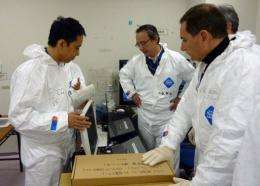Into the no-man's land of Fukushima

Every two minutes on the bus ride through the ghost towns surrounding Japan's Fukushima Daiichi nuclear plant, a company guide in a white protective suit holds up a display showing the radiation level. And it is rising.
Passing through the disaster exclusion zone visitors catch sight of houses that look like they could be anywhere in Japan, except for the odd sign that there is no-one to look after them; that no-one has lived here for nearly a year.
Occasionally an animal appears in a garden, left to fend for itself by owners who fled when the plant's nuclear reactors began spewing their poison last March.
Still the radiation level is rising.
The small delegation of visitors, including an AFP journalist, sit quietly on the bus, covered head to toe in suits designed to keep radioactive particles off their skin, their clothes and out of their hair.
A row of pine trees stands at the entrance to Fukushima Daiichi, a name that has become become etched into public consciousness over the past 12 months as the world watched the worst nuclear accident in a generation unfold.
Still the radiation level is rising.
The nervous chatter quietens and some on the bus pull their protective suits tighter around their necks before full face masks that cover the eyes, nose and mouth are handed out.
Dosimeters tucked inside the suits silently measure any radiation that makes it through the protective gear as passengers file out of the bus in front of the mangled remains of one of the reactors.
Twisted metal and debris litter the ground near the building, which was partially destroyed by a hydrogen explosion following the enormous tsunami that swept through an unprepared power station last March.
The now gentle waves lap at the shore just metres (yards) from the tour group as it passes broken vehicles and splintered trees that are still to be cleared.
A five-minute ride away is the plant's control centre, a building that is fully staffed round the clock by some of the 3,000 workers at the plant whose duty it is to tame the reactors.
Among the half dozen bunk beds that line the room, French Energy and Industry Minister Eric Besson is briefed on efforts to shutter the plant, a project that even the most optimistic say will take decades.
Besson, the first foreign politician to set foot inside the plant since the disaster struck, urges courage from the employees and contract workers for Tokyo Electric Power who spend their days at the plant.
For France, which relies on nuclear power for 80 percent of its electricity needs, the blow to nuclear power that Fukushima struck hit home hard.
"We continue to believe in a civilian nuclear energy programme operated in the safest possible way. We are relying on you to revive this sector," Besson told workers.
For power-hungry Japan, a solution to its energy problems cannot come soon enough.
All but a handful of its 54 reactors are offline amid public disquiet over the safety of the technology. Within weeks of the anniversary of the disaster on March 11, the last of them is expected to be switched off.
Back on the bus, the minister and his entourage remove their masks again.
The company guide shows them the radiation reading.
Passengers stare out of the window as they pass back through the gates of the plant and back into the no-man's land of the exclusion zone, where tens of thousands of people were forced from their homes.
In parts of this zone, people will be allowed back some time in the next year or so.
Other areas will be uninhabitable for 30 years.
The bus winds its way back through empty villages, past the deserted houses.
And the radiation reading begins to fall.
(c) 2012 AFP





















